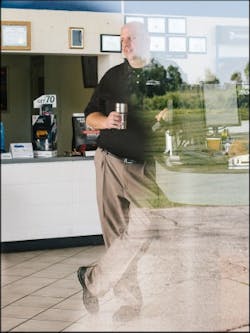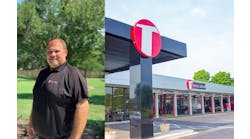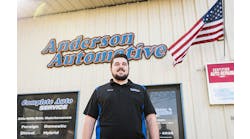Dan Garlock doesn’t mince words when it comes to digital marketing: “If you don’t start embracing this kind of stuff, you’re going to get passed by,” he says. “The dealers and big box stores understand this and they’re using it to their advantage and to their benefit.”
But knowing and doing are often two separate things: Although his shop, Silver Lake Auto Center in Oconomowoc, Wis., has had a website since the early 1990s, Garlock says that the shop’s online presence wasn’t the “cutting edge” approach that he wanted it to be. And what’s more, that presence was starting to wreak havoc on his advertising budget. Garlock says that because his website hadn’t been refreshed recently, the pay-per-click campaigns he was attempting to manage were eating up his budget and generating few clicks.
“I had to pay a fortune,” he says.
Garlock knew that the industry would continue to trend toward digital marketing, and with the goal of getting in front of the trend, he decided to make a change: He would overhaul his pay-per-click campaigns with an eye on best practices, ROI and his budget.
THE BACKGROUND
Garlock describes Silver Lake Auto Center as doing a little bit of everything: It’s a member of the national The Hybrid Shop program, sells Michelin and Goodyear tires, works on diesel engines, performs emissions testing, and does towing. The high volume shop, which has an average monthly car count of 520 and pulls in $3 million in annual sales, also has been family owned since 1973 and has established a strong presence in the community.
It’s a recipe for a winning shop, and it’s why Garlock felt especially strong about reaching the diverse range of customers the shop services.
“Instead of shotgunning everyone’s mailboxes with direct mail pieces and letting them know we have a tire promotion going on right now, I wanted to be able to dial in and find those customers who need tires today and bring them directly to our business,” he says.
THE PROBLEM
Although Garlock had always been in charge of the shop’s marketing—a role he thoroughly enjoyed—he says that as the years went on, it became increasingly time consuming and difficult to keep up.
Garlock wanted to generate more traffic to the website, increase his Google search rankings and make sure customers were actually finding what they were searching for on his site.
In its simplest form, pay-per-click campaigns have business advertisements automatically appear on Google when local consumers search a specific set of keywords relevant to the shop. Every time the ad is clicked, which brings consumers to a landing page on the shop’s website, the campaign owner pays a small fee, which can range from $2 to $7 per click.
And with the business opening a second location in Hartland, Wis., he knew he wanted digital marketing to be a focus in launching the new location.
THE SOLUTION
If done well, pay-per-click campaigns can generate up to a 25 percent phone conversion rate for every click, says Garlock. This is especially important as it becomes more difficult to drive organic website traffic.
It’s why Garlock decided to partner with Autoshop Solutions to implement a pay-per-click plan and pilot some of the newest trends in digital marketing.
Garlock explains the steps taken to create a successful pay-per-click campaign for Silver Lake:
1. Refresh the website. Garlock updated his website to include more content, clean coding, the same name, address and phone number. He says the goal was for the site to display professionalism, a call to action and include numerous landing pages.
Every pay-per-click ad should direct people to a specific page on your website that’s highly relevant and applicable to the keyword search, he says. Search engines, such as Google, want to provide the best possible user experience and will penalize advertisers who don’t direct people to relevant content. Garlock says that his goal is to make the landing page relate as clearly to the ads and keywords are possible.
Otherwise, ads won’t show up as often as they could or could start showing up for unrelated searches.
He has a landing page for hybrids, tires, towing, shop history, services, specials, contact information, and scheduling.
2. Narrow in on the customers to target. The next step was figuring out exactly whom the target customers were going to be. Considerations were given to geographic needs, the typical customer, the typical cars that comes in, the competitors.
Garlock decided to target customers for tires, hybrid services and towing, and he aimed to target those geographically. Because the shop runs next to Interstate 94, Garlock decided to target the campaign within 10 miles of the freeway, so that if someone breaks down and searches “tow truck near me,” his shop is number one on their search.
“That has helped our towing immensely,” he says. “We’re finding those customers who need towing today and we’re bringing them directly to our website, turning those clicks into phone calls and transitioning that into business for our shop. It’s a more precise way of marketing, for people who have a real-time need for some of the services we offer.”
3. Create the campaign. The next step is building a campaign inside Google AdWords using keywords such as tires, hybrid shop, auto repair, and towing.
Garlock also identified the best time of day and geographic locations for their ads to run. That can be a bit of a guess-and-check process at first, but long-term data can help shops fine-tune their strategy.
4. Track the results. Garlock set up a unique phone number separate from his normal shop line that consumers can only acquire through the paid ad. That way, he could easily assess the success of the pay-per-click campaign.
Autoshop Solutions also set up a phone call recording tool, so the shop could hear how the conversions were going.
“It allowed us to go deep and diagnose, if we have a car count problem, where the problem is,” he says. “Is it the keywords? The wrong targeted customer? Is it our service advisors not converting those sales into appointments? Recording the phone calls has allowed us to internally train and assess our phone skills. It’s helped us embrace our professionalism.”
Garlock is also able to track results through Google Analytics, which allows him to see how many clicks came in, what they were searching for and the device they were using.
THE AFTERMATH
Garlock’s current marketing budget is 5 percent of total annual sales—65 percent of which is dedicated to his pay-per-click campaigns. It’s significant, but the pay-off has been worth it: Within six months, the program brought 2,019 visitors to the website, all of which were from within a 10-mile radius from the shop and 80 percent of which were new visitors to the website.
Nearly 25 percent of those visitors turned into phone calls for the shop, which Garlock says has been a huge factor to the 10–12 percent annual growth rate at the Oconomowoc location and the 25–30 percent growth rate at the new Heartland location.
LOCATION: OCONOMOWOC, WIS.
SIZE: 6,500 SQUARE FEET
BAYS: 7
STAFF: 18 (9 TECHS, 3 FRONT
OFFICE STAFF, 3 SERVICE ADVISORS,
2 TOW TRUCK DRIVERS, 1
OWNER)
ANNUAL REVENUE: $3 MILLION
AVERAGE MONTHLY CAR COUNT:
520
THE TAKEAWAY
The key to making pay-per-click work is simple: It’s not a stand-alone tool. You need a good website that’s search engine optimized, fresh content, and solid phone conversion skills for the campaigns to be successful. That simple rule is why many shop owners have difficulty executing the campaigns correctly.
“If it’s not relevant to the search, Google is going to jack your price way up,” Garlock says. “They’re looking at how relevant you are and your budget. If you don’t have a correctly built landing page, you’re going to drop down in the rankings or you’re going to pay an extreme amount of money. But at the same time, if you don’t embrace your professionalism on the phone or in person, you’re also not going to be effective.”
For Garlock, he sees these types of digital marketing campaigns not only as a successful tool for his shop, but also as the future of marketing.
“If we don’t as independent shops step up our game and hold on to that market, we’re going to have it taken from us,” he says. “It all starts with marketing. If you’re short there, everything starts to tumble after that. You have to market correctly and deliver a superior product.”
EXPERT ADVICE
Effectively leveraging new marketing tactics, such as Google AdWords campaigns, can sometimes be difficult for shop owners. And tracking results is a critical step. Anne Lazo, CEO of marketing firm Motorhead Advantage, discusses how to evaluate if a marketing tactic is right for you.
When it comes to different marketing activities, things that work for some shops might not work for other shops. It all depends on your area, who you’re trying to target and the message. What I like to do is start with the tried and true: You need a website, it has to be mobile responsive, you need to have content on your website, and you need to participate in social media.
Once you know your budget for that and tracking results, when a new marketing tactic pops up, you can decide, does this fit into my marketing budget? How much do I want to put toward it? How many months should I put toward it? You’re going to want to do six months.
I think the biggest thing that shop owners forget to do is to really ask how a customer heard about them. You have to be really diligent with reporting and recording to know if something is working. If you’re not asking how did you hear about us, you’re not going to know if that advertisement is working. Setting up designated phone lines is another way to do this.
If it’s not working after six months, you need to consider why it’s not working. Was your message really targeted to your shop’s personality? Was it for the right people? Maybe the call to action wasn’t right. There are a lot of factors that go into it.



